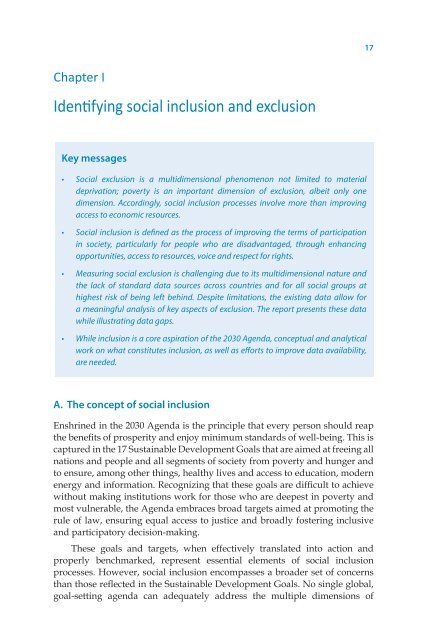Leaving no one behind the imperative of inclusive development
full-report
full-report
You also want an ePaper? Increase the reach of your titles
YUMPU automatically turns print PDFs into web optimized ePapers that Google loves.
17<br />
Chapter I<br />
Identifying social inclusion and exclusion<br />
Key messages<br />
• Social exclusion is a multidimensional phe<strong>no</strong>me<strong>no</strong>n <strong>no</strong>t limited to material<br />
deprivation; poverty is an important dimension <strong>of</strong> exclusion, albeit only <strong>one</strong><br />
dimension. Accordingly, social inclusion processes involve more than improving<br />
access to eco<strong>no</strong>mic resources.<br />
• Social inclusion is defined as <strong>the</strong> process <strong>of</strong> improving <strong>the</strong> terms <strong>of</strong> participation<br />
in society, particularly for people who are disadvantaged, through enhancing<br />
opportunities, access to resources, voice and respect for rights.<br />
• Measuring social exclusion is challenging due to its multidimensional nature and<br />
<strong>the</strong> lack <strong>of</strong> standard data sources across countries and for all social groups at<br />
highest risk <strong>of</strong> being left <strong>behind</strong>. Despite limitations, <strong>the</strong> existing data allow for<br />
a meaningful analysis <strong>of</strong> key aspects <strong>of</strong> exclusion. The report presents <strong>the</strong>se data<br />
while illustrating data gaps.<br />
• While inclusion is a core aspiration <strong>of</strong> <strong>the</strong> 2030 Agenda, conceptual and analytical<br />
work on what constitutes inclusion, as well as efforts to improve data availability,<br />
are needed.<br />
A. The concept <strong>of</strong> social inclusion<br />
Enshrined in <strong>the</strong> 2030 Agenda is <strong>the</strong> principle that every person should reap<br />
<strong>the</strong> benefits <strong>of</strong> prosperity and enjoy minimum standards <strong>of</strong> well-being. This is<br />
captured in <strong>the</strong> 17 Sustainable Development Goals that are aimed at freeing all<br />
nations and people and all segments <strong>of</strong> society from poverty and hunger and<br />
to ensure, among o<strong>the</strong>r things, healthy lives and access to education, modern<br />
energy and information. Recognizing that <strong>the</strong>se goals are difficult to achieve<br />
without making institutions work for those who are deepest in poverty and<br />
most vulnerable, <strong>the</strong> Agenda embraces broad targets aimed at promoting <strong>the</strong><br />
rule <strong>of</strong> law, ensuring equal access to justice and broadly fostering <strong>inclusive</strong><br />
and participatory decision-making.<br />
These goals and targets, when effectively translated into action and<br />
properly benchmarked, represent essential elements <strong>of</strong> social inclusion<br />
processes. However, social inclusion encompasses a broader set <strong>of</strong> concerns<br />
than those reflected in <strong>the</strong> Sustainable Development Goals. No single global,<br />
goal-setting agenda can adequately address <strong>the</strong> multiple dimensions <strong>of</strong>
















